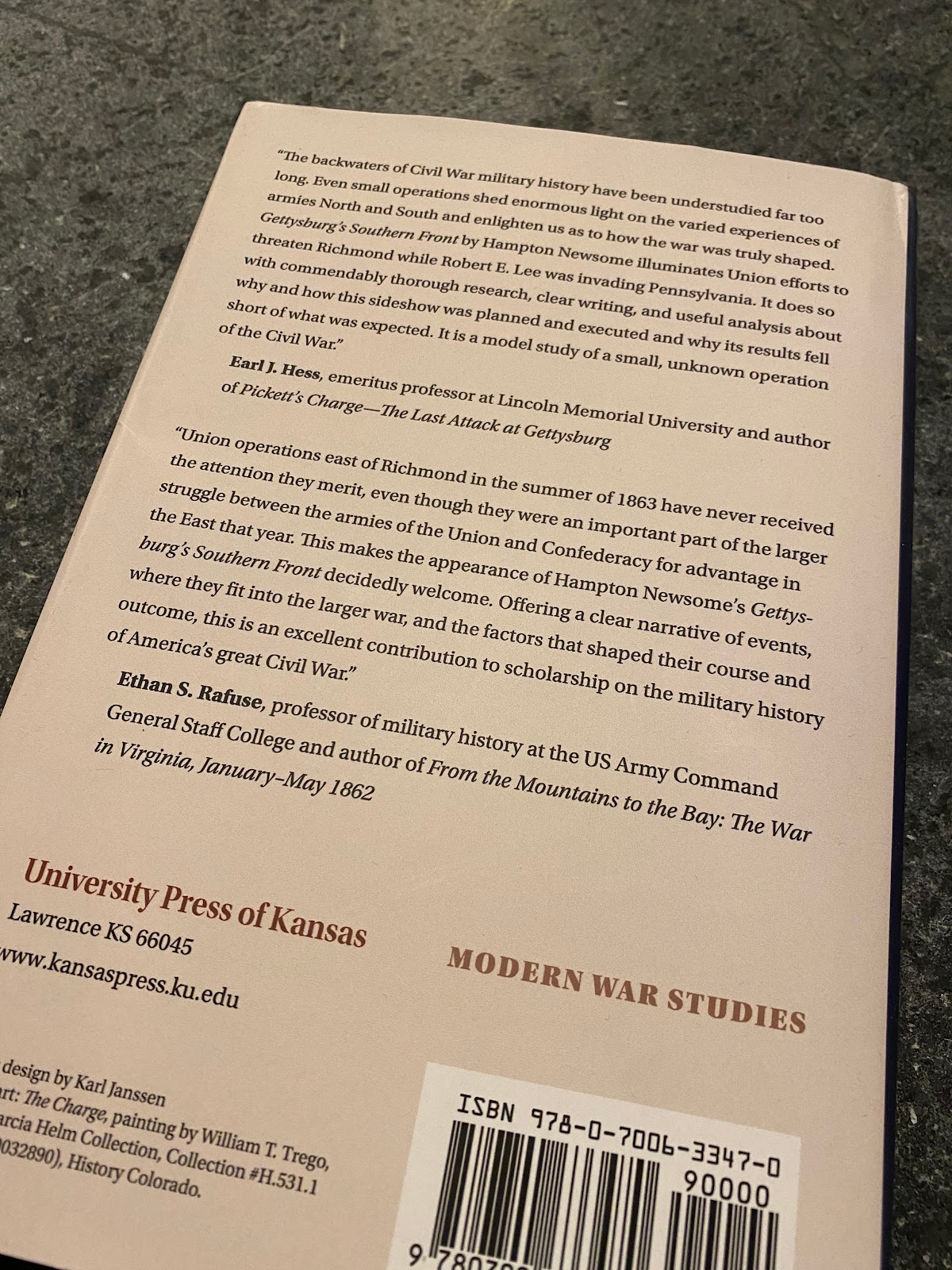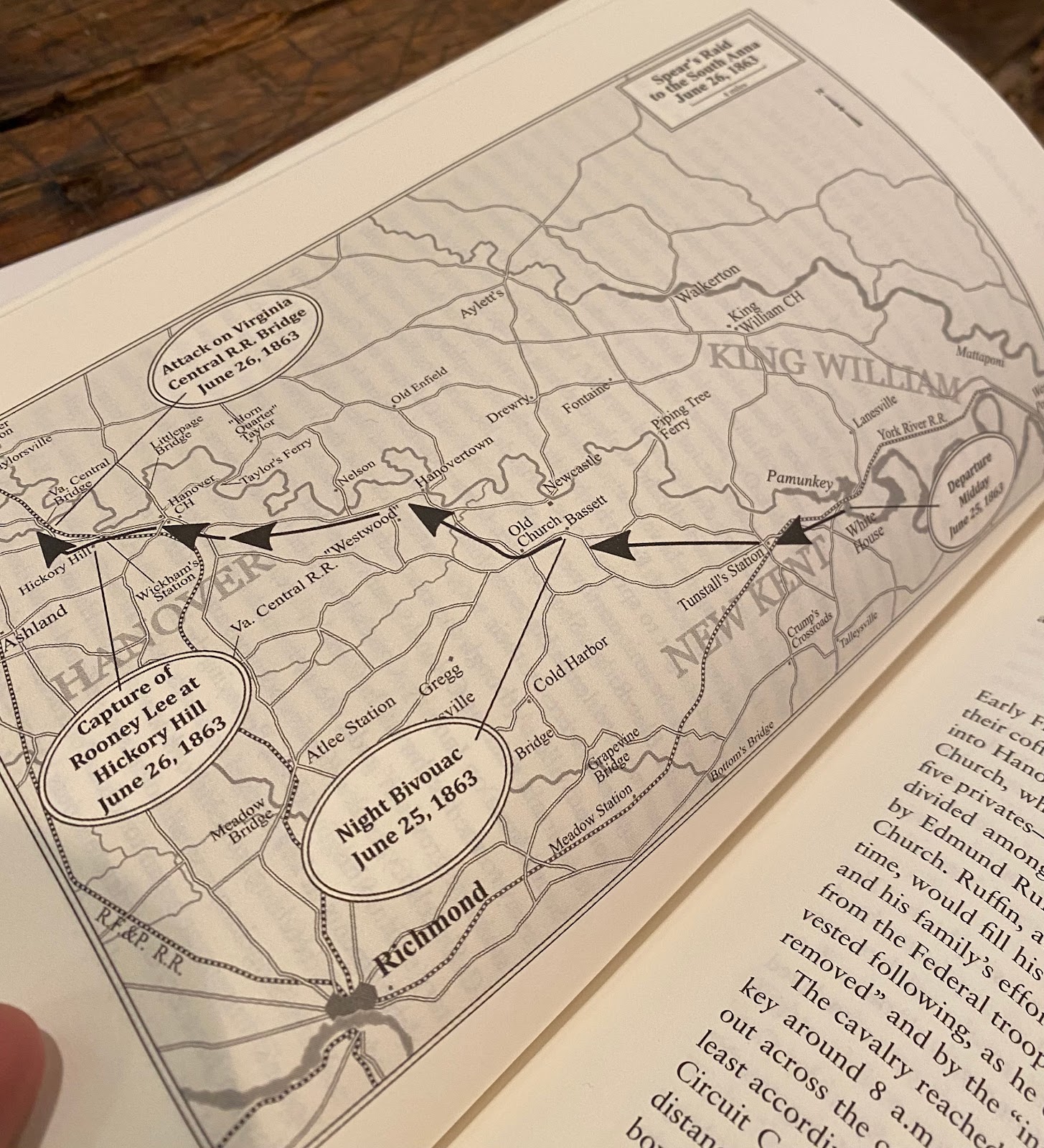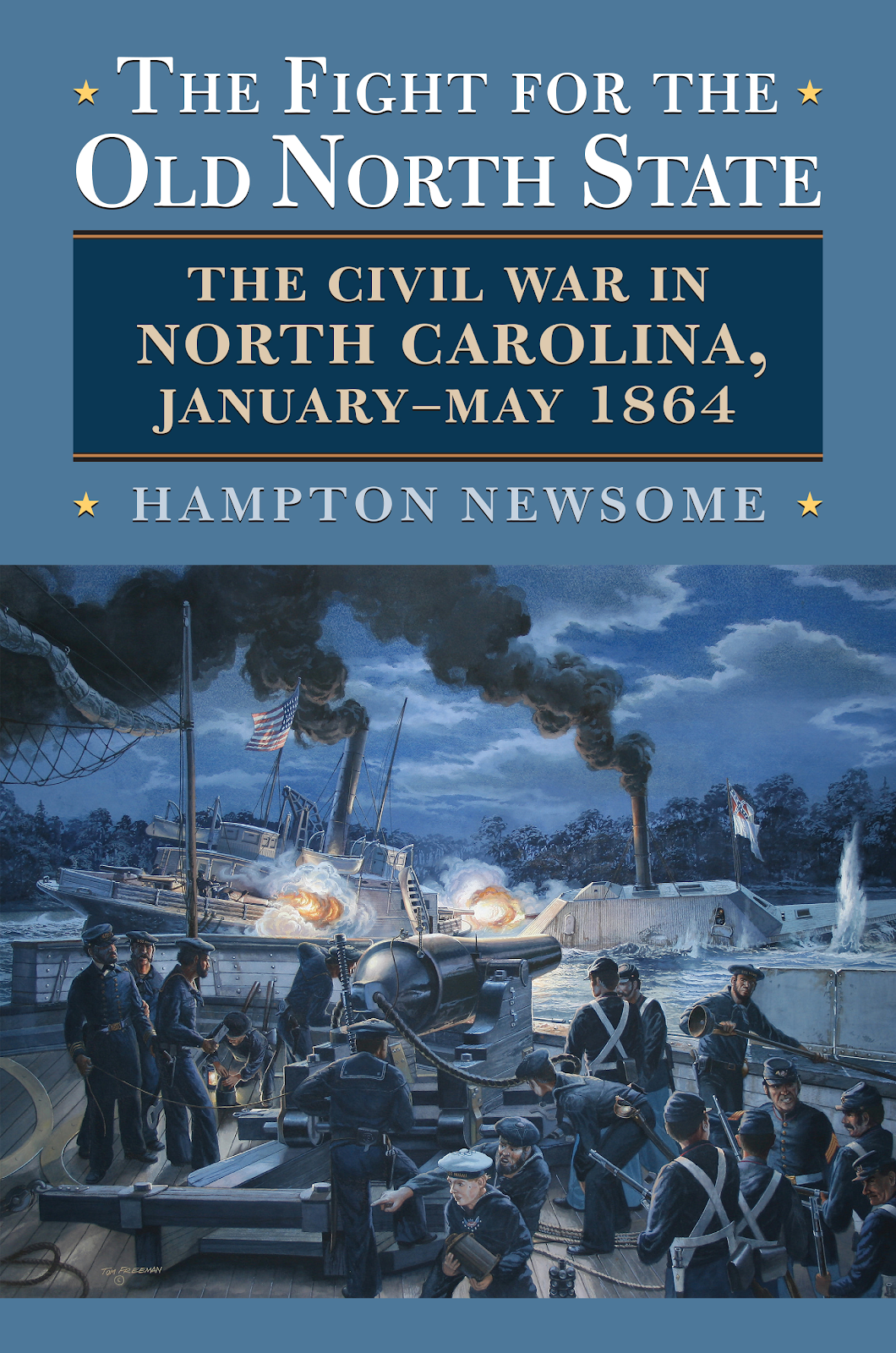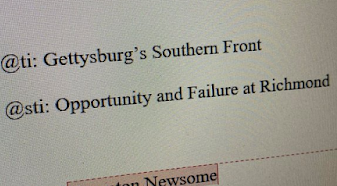I enjoyed this interview with Bjorn Skaptason at Abraham Lincoln Book Shop, Inc. about my new book, Gettysburg's Southern Front, from University Press of Kansas. You can check out the interview here and order the book here.
Pages
Pages
Thursday, December 29, 2022
Monday, December 12, 2022
Book Review from Civil War Books and Authors: Gettysburg's Southern Front
"As expected, Newsome marshals all of his prodigious research abilities and writing talents, along with strong map support, to craft yet another masterful microhistory of a lesser-known military operation. Dix's campaign was conducted in distinct phases, all of which are recounted in detail."
Full review is here.
Saturday, November 5, 2022
When 20,000 Federals Advanced on Richmond During the Gettysburg Campaign
From the jacket of Gettysburg's Southern Front:
In this study, Newsome offers an in-depth look into this little-known Federal advance against Richmond during the Gettysburg Campaign. The first full-length examination of Dix’s venture, this volume not only delves into the military operations at the time, but also addresses concurrent issues related to diplomacy, US war policy, and the involvement of enslaved people in the Federal offensive.
Gettysburg’s Southern Front also points to the often-unrecognized value in examining events of the US Civil War beyond the larger famous battles and campaigns. At the time, political and military leaders on both sides carefully weighed Dix’s efforts at Richmond and understood that the offensive had the potential to generate dramatic results. In fact, this piece of the Gettysburg Campaign may rank as one of the Union war effort’s more compelling lost opportunities in the East, one that could have changed the course of the conflict.
Thursday, October 27, 2022
Gettysburg's Southern Front: Crump's Crossroads East of Richmond, July 2, 1863
 |
| Map of New Kent County, Crump's Crossroads Detail (LOC) |
 |
| Erasmus Keyes (LOC) |
Monday, October 3, 2022
Book Release Day: Gettysburg's Southern Front
Many thanks to Joyce Harrison, Kelly Chrisman Jacques, Derek Helms, and the rest of the staff at University Press of Kansas. I really enjoyed this project about a little-known chapter of the Gettysburg Campaign - it was a great opportunity to dig deep into some new ground.
Tuesday, September 13, 2022
Sunday, July 31, 2022
Gettysburg's Southern Front: Available For Preorder
My new book, Gettysburg's Southern Front: Opportunity and Failure at Richmond, is available for preorder from University Press of Kansas (and elsewhere).
"Gettysburg’s Southern Front by Hampton Newsome illuminates Union efforts to threaten Richmond while Robert E. Lee was invading Pennsylvania. It does so with commendably thorough research, clear writing, and useful analysis about why and how this sideshow was planned and executed and why its results fell short of what was expected. It is a model study of a small, unknown operation of the Civil War.”" —Earl J. Hess, author of Pickett’s Charge--The Last Attack at Gettysburg
Wednesday, May 25, 2022
Sunday, May 1, 2022
Sunday, February 13, 2022
Book Update: Gettysburg's Southern Front
The copy-edited files are back with the University Press of Kansas and there is a title: Gettysburg's Southern Front: Failure and Opportunity at Richmond.
I've really enjoyed this project. The book covers the little-known Federal operations against Richmond during the Gettysburg Campaign - an effort by a 20,000-man force led by Major General John Dix. The Federal advance on Richmond was directly connected to Lee's drive into Pennsylvania. Indeed, the primary purpose of Dix's operation was to the cut the railroads linking Lee's army to Richmond and to threaten the city itself as the Army of Northern Virginia marched north. Many Federal leaders at the time saw great potential in the venture, which produced engagements in the fields east of Richmond and at the railroad bridges over the South Anna. I expect many readers will find compelling events and intriguing stories they knew little or nothing about before.
The book demonstrates how Dix's effort at Richmond (coupled with smaller operations in NC and western Va.), was part of a Henry Halleck plan - albeit a weak and poorly-coordinated one - to counter the advance of Lee's army north in June and July. Integral to the study (and discussed at length) are issues such as Lee's logistical situation before, during, and after the battle Gettysburg; debates in Washington about the Richmond strike and other efforts to counter or blunt Lee's Pennsylvania foray; reaction to Lee's invasion by commanders in various US and Confederate departments behind his column; the decisions and efforts of Confederate leaders to defend Richmond while supporting Lee's offensive - among other related issues.
Fingers crossed for a release later this year.
Friday, January 28, 2022
Feb. 1864: That Time George Pickett Executed NC Soldiers in Blue
With the anniversary of the New Bern Expedition and the Kinston Hangings (both covered in detail in The Fight For the Old North State (Univ. Press of Kansas, 2019)), I wanted to re-post a little background on those little-known events.
 |
| The Fight For the Old North State |
On February 1, 1864, Confederate forces led by George Pickett attacked the Union base at New Bern. The plan originated with Robert E Lee, who proposed the operation to Jefferson Davis in early January. Lee believed success would alleviate the supply crisis plaguing the Army of Northern Virginia and quell an emerging peace movement in North Carolina. As N. C. Supreme Court Justice Walter A. Montgomery later explained: "A great majority of the people . . . thought that the time had arrived when the question of peace with the United States government should be considered. It was thought that the contest was hopeless after the surrender of Vicksburg and the defeat . . . at Gettysburg, and that the further effusion of blood and destruction of property should cease." Understanding these concerns, Lee proposed operations in North Carolina hoping to open up the rich agricultural region for Confederate subsistence officers and to boost Confederate morale in the state.
 |
| New Bern, N.C. |
Over several days, Pickett's forces sought to find a way to take the Federal base. The offensive generated pockets of fighting at Bachelor Creek, Newport Barracks, and Brice's Creek. During the expedition, Confederate forces nearly captured and boarded a train headed into the New Bern defenses and managed to seize a Union gunboat, the Underwriter, only to be forced to abandon the prize almost immediately. Ultimately, the Union forces at New Bern under Innis Palmer managed to fend off the rebels and maintain Union control over eastern North Carolina.
 |
| George Pickett |
The hangings triggered swift and widespread condemnation in the Northern press and produced protests from Union officers. Lieutenant Colonel Charles Henry Foster, commander of the 2nd North Carolina Union Volunteers (NCUV,) labeled the hangings an "inexcusable massacre." John Peck, in charge of Federal troops in North Carolina, protested and provided a list of his men captured a New Bern. A truculent Pickett taunted Peck, pointing out that the list "so kindly furnished . . . will enable me to bring to justice many who have up to this time escaped their just desserts."















